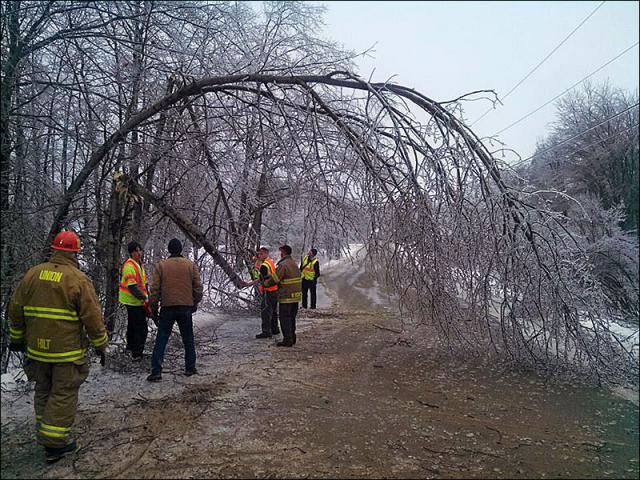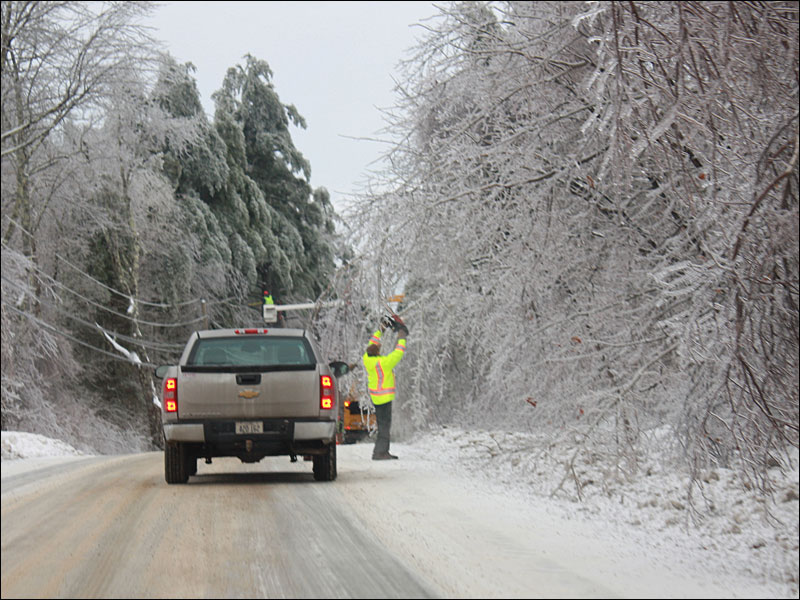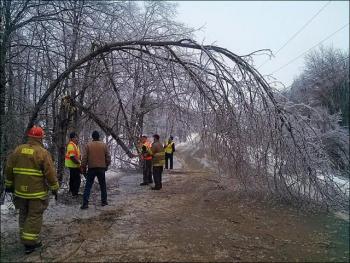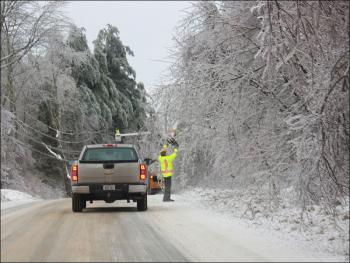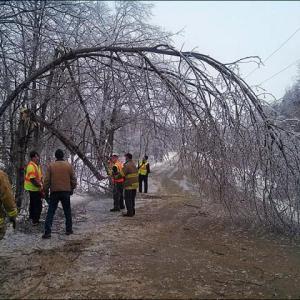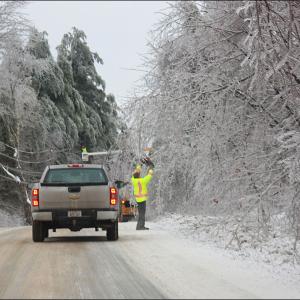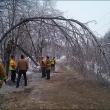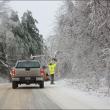Federal government says no disaster funds for Maine following Ice Storm of 2013
Remember the December 2013 ice storm? When approximately 500,000 Maine residents were without power, many for at least a week? When temperatures dipped below zero, and trees in Waldo, Kennebec and Knox counties bent over under a heavy glaze? Businesses shut down during the peak holiday season; holiday travel became arduous, if impossible; municipal offices closed and shelters opened for those without heat. It was a miserable time, especially for the elderly and disabled, but Maine people, stoic to the bone, coped. They brought in more wood, checked on neighbors and communicated with each other on their mobile phones.
And like other states do following disastrous weather, Maine got its paperwork together to apply for federal disaster aid, asking for $1.9 million to help pay for tree removal from roads, for burst pipes, roof damage, loss of food, setting up shelters and warming centers, spreading more salt and sand, and compensating local firefighters for responding to endless calls — fire alarms, generator emergencies, flooded basements and downed tree limbs.
In February, the state submitted a detailed Request for Presidential Disaster Declaration Major Disaster or Emergency to the Federal Emergency Management Agency, outlining storm hardship and damage that occured between Dec. 21 and Jan. 1. Gov. Paul LePage enclosed a Feb. 21 letter, as well, saying the nature of “this emergency was the extreme threat to public safety caused by widespread power outages and debris and ice-covered roads during a period of extreme cold, which put lives at jeopardy and rendered usual means of road treatment ineffective.”
FEMA (Federal Emergency Management Agency) falls under the Department of Homeland Security. Its mission is “to support our first responders and ensure that as a nation we work together to build, sustain, and improve our capability to prepare for, protect against, respond to, recover from, and mitigate all hazards.”
Maine Emergency Management Agency partners with FEMA, and county emergency management agencies. Its mission: “Emergency management protects communities by coordinating and integrating all activities necessary to build, sustain, and improve the capability to mitigate against, prepare for, respond to, and recover from threatened or actual natural disasters, acts of terrorism, or other man-made disasters.”
Every town has its own EMA director, most often, the local fire chief.
The only other New England state to submit a similar request for that storm was Vermont. It was not an atypical process: Since 2007, Maine has been declared a disaster 12 times, and federal funds have flowed to the state for post-storm reconstruction. Last year, Maine received $1.5 million to help Androscoggin, Cumberland, Knox, Sagadahoc, Washington and York counties with costs accrued during a Feb. 8-9 blizzard. For that snowstorm, most of the costs were for emergency response overtime work and for clearing tons of snow from public roads and other public facilities.
This year, however, Maine got a rejection letter March 12 from FEMA Administrator W. Craig Fugate, whose office is in Washington, D.C., for its ice storm aid request.
He told LePage: “You specifically requested public assistance for 16 counties and hazard mitigation statewide. Based on our review of all the information available, it has been determined that the damage from this event was not of such severity and magnitude as to be beyond the capabilities of the state and affected local governments. Accordingly, we have determined that supplemental federal assistance is not necessary.”
Why not? The short answer: Not enough snow fell. (Click here for FEMA’s snow assistance policy)
Also, on Feb. 26, FEMA had rewritten some regulations regarding disaster assistance requests; specifically, FEMA said it would raise the minimum limit on the amount of damage for any one community from $1,000 to $3,000. That affected Maine’s request, resulting in approximately $93,000 in storm costs being disallowed, despite the fact that Maine’s Feb. 21 request had been filed prior to the rule rewrite. In other words, Maine’s request had not been grandfathered.
Vermont, however, did get enough snow to warrant aid.
Vermont also qualified for a declaration because it has two electric utilities that are publicly owned, and those utilities suffered actual damage to their infrastructure. Maine has one, Eastern Maine Electric that primarily serves Washington County, that also had significant damages. But Maine’s threshold for qualifying for assistance is roughly twice that of Vermont (the threshold is population based).
That state heard back from FEMA in late January, learning it had been declared a disaster area by the president, thereby making it eligible for federal money to help repair damaged roads, bridges, parks and pay for other storm-related expenses that had been identified by towns and cities. Other states receiving major disaster declaration by the president this past winter included South Carolina, Georgia, Oklahoma and Pennsylvania. Just recently, Washington and Colorado received disaster declarations.
FEMA’s Disaster Relief Fund can be directed toward recovery efforts associated with domestic major disasters and emergencies that overwhelm state resources, said Jeb Killion, external affairs officer for FEMA Region One (New England).
The February report of FEMA estimates there will be $12 billion available for disaster assistance by the end of March. (See attached PDF for FEMA’s monthly report to Congress).
Much of that money, however, is already obligated for storms that took place over the past decade — Katrina, Sandy, etc.
“Please note that there are several hundred disasters that are being funded out of the DFR,” he wrote, in an email.
The ice storm of 2013 is the first time for many involved in the business of managing Maine emergencies when a FEMA request for aid has been denied.
And there are more than a few who believe FEMA’s policy, which “disallows” factors, such as salt and sand applications, needs reworking.
“It is our feeling that the policy is quite flawed,” said Augusta-based Maine Emergency Management Agency spokesman Lynette Miller, on March 24. “It doesn’t take into account winter storms.”
Moreover, the ice storm failed to qualify as a “record snowfall.”
“A record snowfall is one in which the snow totals come within 10 percent or exceed the record snowfall for a county, as documented by NOAA’s National Climatic Data Center,” said Miller. “That was clearly not the case here. The difficulty we see with this policy is that it lumps ‘severe winter storm’ under this policy. Section K, Severe Winter Storm Declarations, disallows ‘snow removal’ unless the State qualifies for ‘snow assistance’, which would require a record snowfall,” said Miller.
Maine can appeal the March 12 denial within 30 days of the FEMA letter receipt. According to Miller, the state is “trying to determine if the appeals process is worth it.”
As the state learned of the denial, it circulated the FEMA letter to county emergency management directors and town offices.
“I was disappointed,” said Ray Sisk, Knox County’s Emergency Management Agency director, whose office is in Rockland. “We had a lot of people working hard to keep things moving in towns.”
His colleague, Dale Rowley, Waldo County’s EMA director, was of similar sentiment. Was the storm damage in Waldo County during that late December week stretch that significant?
“We thought so,” he said.
In one person’s assessment, “Nobody got anything except the experience of doing paperwork, again.”
In the town of Lincolnville, which was especially hard hit with ice, along with Northport, Hope and Appleton, and where a power outage lasted for at least a week, the denial letter was discouraging. Lincolnville had tallied $37,750 in debris removal expenses, plus another $4,188 in protective measures.
“I'd like to believe that the help and the money would be there if we met the criteria for disaster assistance but apparently we did not,” said Lincolnville Town Administrator David Kinney.
Maine’s request
In early February, the state asked towns and cities to fill out forms identifying damage. Towns that suffered sent their data to the county EMA, and from there, the counties submitted Excel spreadsheets to the state. (see attached PDF for Maine data)
Northport estimated it spent $50,000 on debris removal, trees and bushes that had been coated with ice and blocking roads. That was likewise the case with most Waldo County towns: Liberty spent $100,000 on removing broken limbs, Stockton Springs, $75,000. In total, Waldo County reported $646,403 in public damage. The county’s official threshold for applying for damage reimbursement is $133,812.
Knox County reported similar figures, with $348,414 spent. Much of that was for debris removal, fire department responses, sand and salt for roads, and shelter expenses. The threshold for Knox County is approximately $139,000.
Both counties were well above the threshold necessary for submitting aid requests; in fact, the entire state was above the mark required to ask for federal assistance dollars.
In a Feb. 21 letter (see attached PDF for full text) to President Obama and FEMA Region One, in Boston, Maine’s Gov. LePage cited four pages worth of reasons why help was needed during that period when he declared Maine a state of emergency. The storm delivered up to an inch of ice, and more than 218,000 electricity accounts lost power, affecting more than 500,000 people, and closed hundreds of businesses in the peak pre-Christmas retail period.
Power outages continued through Jan. 1, during extreme cold, and roads remained treacherous. More than 40 shelters and warming centers opened, staffed by volunteers and firefighters, who also conducted door-to-door wellness checks.
Two deaths from carbon monoxide poisoning occurred from improper use of emergency generators, with seven more hospitalizations and even more ambulance calls made for carbon monoxide exposure, the state said.
LePage’s letter noted that the public stopped by the shelters, but as is characteristic of hardy Maine residents, they preferred to return home at night, regardless of hardship.
“However, in at least one case, a local fire department staffed its station around the clock to care for one elderly resident who could not remain in her home,” the letter said. “This level of care is typical of our small towns.”
The state’s letter to FEMA referenced per capita costs of the storm, ranging from $35 Washington County, where a consumer-owned nonprofit utility was knocked out of commission to the tune $1.8 million in damages, to Stockton Springs and Prospect, with $20 per capita costs.
“And the costs to all those communities will only rise when debris clearance resumes in the spring,” said LePage.
“The cost of this disaster falls on state and local budgets already adversely affected by a nationwide recession,” he wrote. “While the state of Maine and Maine communities budget for winter maintenance at the level appropriate to our climate, an event such as the December ice storm requires such a commitment of manpower, equipment and materials it has outstripped those budgets.”
Maine’s Congressional Delegation, National Weather Service weighs in
U.S. Senators Susan Collins and Angus King, Jr., along with Congressmen Chellie Pingree and Michael Michaud followed Maine’s official disaster request with a Feb. 25 letter, bolstering the state’s position before FEMA.
They wrote: “The impact was especially severe in Maine’s rural and economically challenged areas.... We would also note that this event was not just a snowstorm; it was an ice storm coupled with extreme cold.”
They cited Maine’s challenging weather and urged FEMA to consider the nature of the storm in determining eligible disaster costs.
Weathermen from the National Weather Service, itself a federal agency, submitted their own meteorological analysis of the ice storm in the state’s disaster request.
“During the period of Dec. 21-23, northern areas saw up to 10 inches of snow and sleet with many southern areas seeing from one-half to three-quarters inches of ice accretion,” wrote John Jensenius and Todd Foisy. “A few spots reported about one inch of ice. The weight of the ice and later the weight of ice and snow resulted in falling debris, which caused scattered to widespread power outages across the state.”
They also said in their report: “A major winter storm affected the state of Maine from Dec. 21 to Jan. 6,” citing mixed precipitation, subfreezing temperatures, freezing rain, snow, sleet, which resulted in ice remaining on trees for a prolonged period of time. They also said a series of storms deposited more snow, which hampered clean-up efforts, added weight to branches, and resulted in more power outages.”
The process
When a state applies to FEMA for disaster relief it includes data from all the towns. Then, FEMA conducts a public assistance assessment by phone or with site visits.
“After the ice storms, the state of Maine invited FEMA officials to come into the state to assist the state with the assessments of damages by way of the Preliminary Damage Assessment (PDA) teams made up of state and federal officials,” said Killion. “At the direction of the state of Maine, FEMA and the state officials visited the electrical COOP [Washington County], and also at the direction of the state of Maine, they had FEMA and state officials review Category B: Emergency Protective Measures damages from Maine’s communities (Category B, which is a review of damages/funds that were spent by communities to combat the effects of the ice storms on the communities).
“Category B damages are not always seen because they are costs associated with things that communities did and spent as a result of the ice storms. A lot of the damages submitted to FEMA by the state for the ice storms were Category B damages.”
Killion said those Category B measures are measures taken by communities and include warning devices (barricades, signs and announcements), search and rescue, police and guards, sandbagging, shelters and emergency care, emergency repairs and demolition, and removal of health and safety hazards.
“So, at the direction of the state, damages were reviewed in person and by reviewing the Category B damages/costs submitted by communities in Maine,” he said.
The state MEMA paperwork, however, indicates FEMA suggested no site visits.
“The Public Assistance PDA was conducted primarily by a telephone/email survey of communities and affected agencies and associated document review, with no site visits, according to FEMA recommendation with which the state concurred.”
Policy going forward
With Maine’s taxpayers now expected to shoulder the costs of the ice storm through property taxes (as opposed to federal income taxes), county and state EMAs are hoping that FEMA reviews its policy, written in 2009, concerning winter storms and snowfall amounts.
Knox County’s EMA Director Ray Sisk hopes Maine’s denial “puts sand under tires to move the conversation forward.”
The state’s EMA spokesman Lynette Miller said FEMA’s existing policy fails to take into account the ice storms, which can be “more dangerous for northern states, with low temperatures and power outages.”
Those “opposite circumstances” are unique to northern states, and can be more hazardous to public welfare than blizzards.
And Dale Rowley, Waldo County’s EMA director, said it is unlikely that if FEMA’s rules were in effect back in the extremely devastating ice storm of 1998, that Maine would have received nothing in aid from the federal government.
FEMA reviews all of its policies on a year basis, said Killion, at FEMA’s Boston office.
“The state of FEMA considers all the impacts from an event to determine if the event is beyond the state and local government capabilities to respond and recover,” he said. “Please note, that is not anticipated that all occurrences will result in the requirement for federal assistance.”
For the Mainers who plodded through the string of snow storms, ice storm, freezing temperatures, the denial by FEMA is just one more disappointment of a long, hard winter. No towns will be broken by the costs of storm cleanup, but at town meetings questions will likely be raised about storm expenditures.
“While the state of Maine and Maine communities budget for winter maintenance at the level appropriate to our climate, an event such as the December ice storm requires such a commitment of manpower, equipment and materials that it has outstripped those budgets,” write LePage.
That, in turn, leads to deferral of other public works projects, which can be considered essential to local infrastructure, employment, and the local economy.
Related stories:
• Waldo County EMA director seeking individual ice storm impacts for disaster declaration application
• Snow-packed Waldoboro driveway hinders firefighters' attempt to save home
• Red Cross provides comfort, cots to those in need
• UPDATED: CMP crews restore power to more than 100,000 customers as ice storm recovery continues
• Snow in the forecast: Iced-up Midcoast to get the most
• Christmas Eve fire destroys garage at Lincolnville home
• Central Maine Power issues power restoration update, 7 p.m., Christmas Eve
• Storm damage lingers with extensive power outages; Waldo and Knox county shelters, warming centers open
• UPDATE: Belfast, Lincolnville called to help battle overnight house fire in Northport
• UPDATE - Fire heavily damages Union home; family says cat knocked over a candle
• Waldo County EMA, Red Cross shelter open at Troy Howard Middle School
• UPDATED - Storm closings and cancellations; Ice storm warning extended to 7 p.m.
• UPDATED: Lincolnville bearing brunt of power outage, trees falling onto wires, into roads
• It's icy out there, be careful
• UPDATED: Ice storm warning - Freezing rain on snow, make way for a big mess
Editorial Director Lynda Clancy can be reached at lyndaclancy@penbaypilot.com; 207-706-6657.
Event Date
Address
United States

